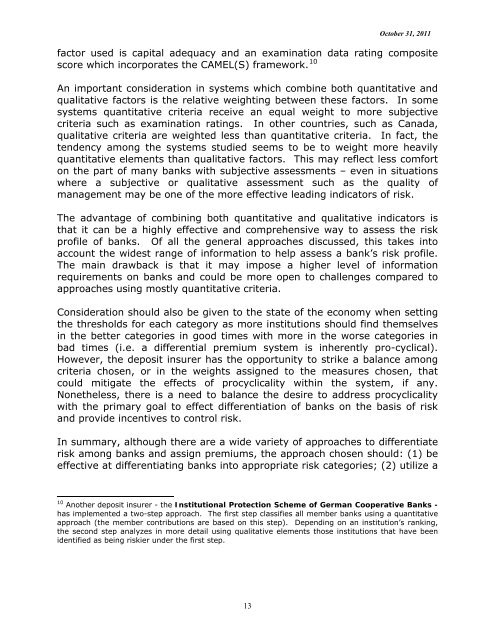General Guidance for Developing Differential Premium Systems
General Guidance for Developing Differential Premium Systems
General Guidance for Developing Differential Premium Systems
You also want an ePaper? Increase the reach of your titles
YUMPU automatically turns print PDFs into web optimized ePapers that Google loves.
October 31, 2011<br />
factor used is capital adequacy and an examination data rating composite<br />
score which incorporates the CAMEL(S) framework. 10<br />
An important consideration in systems which combine both quantitative and<br />
qualitative factors is the relative weighting between these factors. In some<br />
systems quantitative criteria receive an equal weight to more subjective<br />
criteria such as examination ratings. In other countries, such as Canada,<br />
qualitative criteria are weighted less than quantitative criteria. In fact, the<br />
tendency among the systems studied seems to be to weight more heavily<br />
quantitative elements than qualitative factors. This may reflect less com<strong>for</strong>t<br />
on the part of many banks with subjective assessments – even in situations<br />
where a subjective or qualitative assessment such as the quality of<br />
management may be one of the more effective leading indicators of risk.<br />
The advantage of combining both quantitative and qualitative indicators is<br />
that it can be a highly effective and comprehensive way to assess the risk<br />
profile of banks. Of all the general approaches discussed, this takes into<br />
account the widest range of in<strong>for</strong>mation to help assess a bank’s risk profile.<br />
The main drawback is that it may impose a higher level of in<strong>for</strong>mation<br />
requirements on banks and could be more open to challenges compared to<br />
approaches using mostly quantitative criteria.<br />
Consideration should also be given to the state of the economy when setting<br />
the thresholds <strong>for</strong> each category as more institutions should find themselves<br />
in the better categories in good times with more in the worse categories in<br />
bad times (i.e. a differential premium system is inherently pro-cyclical).<br />
However, the deposit insurer has the opportunity to strike a balance among<br />
criteria chosen, or in the weights assigned to the measures chosen, that<br />
could mitigate the effects of procyclicality within the system, if any.<br />
Nonetheless, there is a need to balance the desire to address procyclicality<br />
with the primary goal to effect differentiation of banks on the basis of risk<br />
and provide incentives to control risk.<br />
In summary, although there are a wide variety of approaches to differentiate<br />
risk among banks and assign premiums, the approach chosen should: (1) be<br />
effective at differentiating banks into appropriate risk categories; (2) utilize a<br />
10 Another deposit insurer - the Institutional Protection Scheme of German Cooperative Banks -<br />
has implemented a two-step approach. The first step classifies all member banks using a quantitative<br />
approach (the member contributions are based on this step). Depending on an institution’s ranking,<br />
the second step analyzes in more detail using qualitative elements those institutions that have been<br />
identified as being riskier under the first step.<br />
13

















